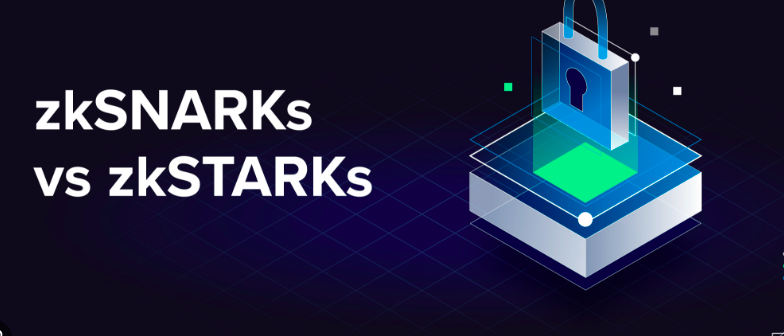In the world of cryptography, Zero-Knowledge Proofs (ZKPs) have garnered much attention, especially regarding blockchain technology and computations that protect privacy. ZK-SNARKs (Zero-Knowledge Succinct Non-Interactive Argument of Knowledge) and ZK-STARKs (Zero-Knowledge Scalable Transparent Argument of Knowledge) are two common varieties of ZKPs.
They both have the function of enabling one party to demonstrate to another that they have specific knowledge without actually disclosing the information. Still, they are not the same in several important ways, such as their underlying ideas, effectiveness, and application scenarios. We will examine the differences between ZK-SNARKs and ZK-STARKs in this thorough comparison to provide readers with a clear picture of their advantages and disadvantages.
What is ZK Snark?
A ZK-SNARK is a cryptographic method that enables one party to demonstrate to another that they have specified information without actually disclosing that information. ZK-SNARKs generate concise, effective proofs that are easily verifiable, which makes them appropriate for use in applications such as computations that protect privacy and blockchain transactions. Their foundation is on converting problems into polynomial equations, and their proof size is usually small, a few hundred bytes at most. They do, however, need a trusted setup process, which, if improperly handled, might provide security problems. ZK-SNARKs have transformed efficiency and privacy across a range of technical areas.
Differences Between ZK Snark & ZK Stark
ZK-SNARKs and ZK-STARKs are two well-known cryptographic methods in the field of zero-knowledge proofs, each having special advantages and traits. Zero-knowledge proof blockchain preserves data privacy while maintaining transparency and this section explores the key differences between these two methodologies, illuminating their underlying ideas, trust structures, proof sizes, and applicability to different scenarios.
1. Structure and Underlying Principles:
The “quadratic arithmetic program” (QAP) is the cryptographic primitive upon which ZK-SNARKs are built. They function by first turning the knowledge issue into a system of polynomial equations, and then producing a brief, static proof that the equations are fulfilled. Because of their great efficiency and ability to provide concise, straightforward proofs, ZK-SNARKs are well-suited for a wide range of applications, such as privacy-preserving smart contracts and blockchain transactions.
ZK-STARKs, on the other hand, use another cryptographic technique called “error-correcting codes.” They use a particular mathematical framework that includes low-degree testing and quick Fourier transforms to achieve scalability and transparency. More transparent, ZK-STARKs don’t need a trusted setup—a crucial feature for many applications, particularly those involving blockchain technology.
2. Trust Setup:
The idea of trust setup is one important way that ZK-SNARKs and ZK-STARKs differ. To use ZK-SNARKs, participants must guarantee the security of a set of initial parameters established during the trusted setup phase. The integrity of the entire system may be in danger if the setup process is tampered with or hacked since this might result in the production of fictitious evidence. One prominent drawback of ZK-SNARKs is this trust arrangement.
ZK-STARKs, however, do away with the requirement for a reliable setup. This characteristic is sometimes called “transparent,” as system security does not depend on a collection of people or institutions guaranteeing the security of parameters. ZK-STARKs provide a significant security and decentralization advantage over trusted setups, which makes them appealing for use in blockchain applications.
3. Proof Size and Verification Complexity:
ZK-SNARKs are very efficient in terms of proof size because of their reputation for having compact proofs. Usually, the proofs are only a few hundred bytes long and are easily verifiable. Because of this, ZK-SNARKs may be used in applications like cryptocurrency transactions where it’s important to minimize the size of the proof and verification time.
ZK-STARKs, in contrast, have bigger proof sizes than ZK-SNARKs. The main causes are transparency and the removal of trusted setup, which results in larger proof sizes. ZK-STARK proofs are less efficient in terms of proof size than ZK-SNARKs because they are usually several kilobytes. ZK-STARK verification also requires greater computing power, although this trade-off is frequently acceptable for situations where trustlessness and transparency are critical.
4. Security Guarantees:
ZK-STARKs and ZK-SNARKs offer robust security assurances. They are made to ensure that the verifier can quickly determine whether the proofs are legitimate and that the prover cannot deceive or provide fraudulent evidence. The degree of difficulty of particular mathematical problems, such as the discrete logarithm problem or the difficulty of decoding error-correcting codes, determines how secure these protocols are. Explore a range of cutting-edge zero-knowledge proof services that enhance privacy and security.
5. Use Cases:
The unique use case and application priorities are frequently the deciding factors when selecting between ZK-SNARKs and ZK-STARKs:
Applications that don’t care as much about the necessity for a trustworthy setup and that demand concise proofs and quick verification are a good fit for ZK-SNARKs. They have been frequently employed when evidence size and verification efficiency are crucial, such as privacy-preserving transactions in blockchain networks and authentication systems.
Applications that need transparency, trustlessness, and the lack of a trusted setup are better suited for ZK-STARKs. This makes them especially appealing to blockchain-based systems that want to improve security and decentralization by eliminating the need for a centralized setup procedure.
6. Trade-offs:
ZK-SNARKs and ZK-STARKs offer different trade-offs:
ZK-SNARKs need a trusted setup, but they are more efficient in proof size and verification speed.
ZK-STARKs improve security, remove the requirement for a trusted setup, and offer transparency, but they have bigger proof sizes and more difficult verification.
Conclusion:
In the dynamic field of cryptography and blockchain technology, ZK-SNARKs and ZK-STARKs are essential for augmenting security and privacy. The application’s priorities and particular requirements will determine which option is best. ZK-STARKs perform well when trustlessness and transparency are critical, while ZK-SNARKs perform well when compact proofs and effective verification are important. It is crucial to comprehend the distinctions and compromises between these two cryptographic instruments to choose the best option for a particular use case. Find the right zero knowledge proof development company to tailor solutions that meet your specific privacy and authentication needs.









